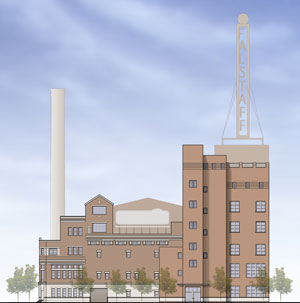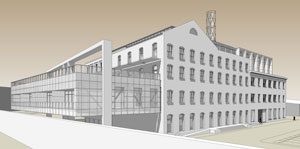Talk to Chris Goad, a senior architect with Wayne Troyer Architect in New Orleans, and you begin to envision a future for this storm-battered city that includes electricity-generating wind turbines sprouting from the rooftops of former factory buildings. David Miller, a real estate developer, has a slightly different but equally compelling and sustainable future in mind: one that integrates affordable housing throughout all neighborhoods.


Falstaff Brewery: Courtesy HMS Architects (top) Rice Mill Lofts: Courtesy Wayne Troyer Architect (bottom)
The future may not be as far off as it seems. Working with developer Sean Cummings, Goad’s office is converting a derelict mill into the Rice Mill Lofts, an apartment and retail complex that aims to become the first LEED Gold-certified mixed-use project in Louisiana. And Miller, a vice president of the Renaissance Property Group, is redeveloping the abandoned Falstaff Brewery into mixed-income apartments. While the conversion of aging industrial buildings for residential use is nothing new in New Orleans, these projects suggest new directions for the city and its architecture.
Located in the city’s historic Bywater neighborhood, the Rice Mill Lofts will contain 50 residential units as well as ground-floor retail shops. With green features such as a 127-foot-tall wind turbine—whose form evokes a smokestack—photovoltaic arrays, and rainwater reclamation, it has already earned a merit award from the American Institute of Architects’ New Orleans Chapter (RECORD, March 2007, page 36). Despite its green features, though, Goad believes the project would be easy to replicate. “We really didn’t have to do a lot to renovate this old mill building into apartments,” he explains. “I believe there’s lots of opportunity in New Orleans to do this kind of project.”
Across town, in the Mid-City area, David Miller also sees untapped potential that could stem from his own redevelopment scheme. Renaissance is taking a 204,000-square-foot former beer brewery and converting it into 149 apartments, half of which are set aside for people making less than the city’s median income. “Projects like Falstaff could be hugely positive for re-development. I believe it will serve as a catalyst for the area,” he says.
The Falstaff building has been a landmark since 1912—its neon sign, some 13 stories high, is visible throughout the city—but it sat vacant for nearly three decades in a neighborhood now filled with bail-bond offices and convenience stores. HMS Architects, with associate architect Webster Design, chose to retain the existing structure, preserving as much of its character as possible. Keith Steger, of HMS, explains that this move allowed for the creation of living units with large window bays and high ceilings—a boon to future residents.
The Falstaff Brewery should be ready for occupancy by the end of this year, while construction on the Rice Mill Lofts is expected to finish in the summer of 2008. For a city in desperate need of new housing, these dates can’t come soon enough.

Post a comment to this article
Report Abusive Comment